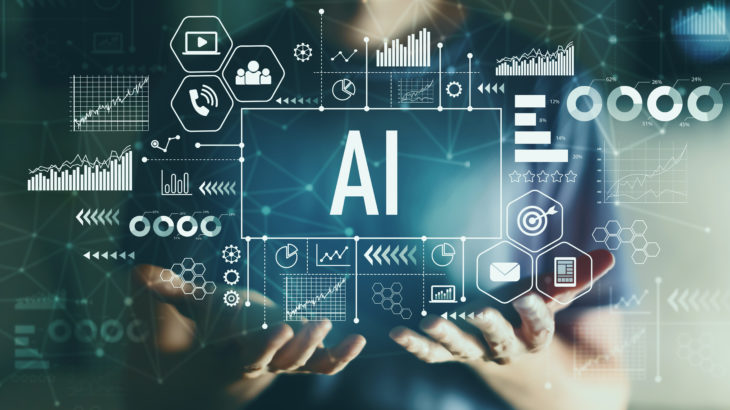Currently, there are still businesses that consider that software development solutions that involve the use of Artificial Intelligence and Machine Learning are exclusive for large companies.
But that is a consideration quite far from reality; currently these tools offer a range of solutions to small and medium-sized businesses.
It is expected that in 2030 the impact of artificial intelligence will lead to a growth of 14% in global GDP.
Likewise, Machine Learning is a trend that is increasingly permeated with companies that benefit from technology in their different areas such as: Industries, retail and detail companies, banking, logistics, health, among others.
In the following graph you can see how the AI market has been increasing its participation, generating increasingly growing profits.
Follow this reading and find out how AI (Artificial Intelligence) and ML (Machine Learning) have evolved businesses today .
Role of Artificial Intelligence and Machine Learning
Automated processes are revolutionizing various social, business and economic aspects, often going unnoticed by our environment.
Algorithms in Artificial Intelligence and Machine Learning are an essential part of the interaction with social networks, electronic commerce, banking operations, tourism, among others linked to services and work.
AI and ML involve in their activities the use of software robots that execute daily and routine tasks in any area of a company, in less time and with greater effectiveness.
Therefore, hyper automation processes require a perfect combination between Artificial Intelligence, Machine Learning and RPA , such as those developed at Valtx, to strengthen the digital transformation you need.
So, what is the relationship between Artificial Intelligence and Machine Learning?
AI is the mix of innovative custom enterprise software development where hardware, programming codes and algorithms are combined that give machines the capabilities to detect, understand, act and learn with levels of intelligence similar to humans.
Therefore, currently AI stands out for two characteristics :
Machine Learning .
This part corresponds to Machine Learning , where the data and parameters are entered which allow determining the response that should be given .
At that moment the algorithm is applied and in turn adjustments are made as the result (learning) is squared with the most satisfactory known answer.
Each time this algorithm is executed, the amount of data in the system increases, which causes the ML to learn and process a greater number of decisions for each variable and, in turn, a data history is generated.
Natural language processing
Also known as NLP (Natural Language Process), natural language processing is the way a machine interprets human language.
Determine word meanings, grammar usage, and language semantics; All of this involves a process of learning and distinguishing between languages, countries and contexts.
For this reason, the concept of Machine Learning is a discipline belonging to Artificial Intelligence, where software algorithms are used to train technological teams to identify data patterns to develop predictive analyses .
In this way, these devices can execute activities autonomously, evaluating the possible responses to apply according to the data pattern received.
For example: If you write a greeting on a computer with AI, the ML must know that it is a greeting and will give you a response according to what you wrote.
So, ML and NLP together with Deep Learning (DL) are immersed within AI forming a whole . You can understand this better by looking at the following graph where these elements are related.
The impact of Artificial Intelligence and Machine Learning on companies
To begin with, ML has two key axes in information processing that must be considered and adequately addressed in order to achieve the objectives in the implementation of AI in the business.
- Data analysis and pattern extraction
- Predicting events and responses.
For this reason, Accenture mentions that the use of these two areas of ML will increase the productivity of companies by up to a projected 40% by 2035.
Then, when you manage to correctly extract the data and behavior patterns of your clients and users, you can move on to the second axis where all the possible responses and actions to a request will be evaluated according to the information stored and what the machine learned in that extraction. of patterns.
Therefore, in this new reality of industry 4.0 , virtuality, the cloud, IoT and artificial intelligence are part of the resources that must be incorporated into production processes .
Among some of the impact areas of these process digitalization technologies, we can mention the following:
The increase in productivity.
- Reduction of the possibilities of human error, which implies greater effectiveness in less time .
- Employees can engage in higher-level tasks, while machines perform repetitive, routine activities.
- The management of information through Big Data and Data Analytics will improve business strategies .
Better quality of life for employees
- Leaving mechanized tasks to industrial robotization or RPA will allow the development of creativity in the performance of other more complex tasks.
- Interaction with AI will give employees new emotional and intuitive capabilities when analyzing work situations.
Improve customer experience
- Giving better and faster responses according to customer demand will allow you to know them better and establish commercial strategies that are more tailored to their needs.
- Some ERPs are implementing these solutions with custom software developments to promptly satisfy those needs.
Know your products better
- With all the data analysis that an AI installed in your company can give you, you will be able to properly manage the products and services you sell .
- From storage, distribution and sale, the exact location, by quantities, batches and other details, offers you opportunities to optimize control and management processes more efficiently and in real time.
6 application examples of Artificial Intelligence
As you already know the impact that the application of these technological tools can have in your business environment, we want to close this article by giving you some practical examples where you can see AI and ML in operation.
When obtaining recommendations for products and services
It is the solution applied by streaming services such as Spotify and Netflix , where both platforms analyze your behavior and interest to offer you options that are more tailored to your tastes and style.
Service automation with chatbots
These tools have been the main reference in the presence of artificial intelligence. It is an efficient way to serve clients and users in media such as websites.
Banks have taken advantage of this software product development services to create greater customer loyalty with more agile attention to their services .
Speech recognition
Who hasn’t heard of Amazon’s Alexa or Apple’s Siri? They are the best examples of AI in action.
The increase in responses in these systems is due to the continuous learning of ML that adds new algorithms and patterns to keep up with users .
Image recognition
Have you ever used it in Google Photos? This tool allows you to recognize all your family members in the photos on your Smartphone thanks to the built-in Artificial Intelligence.
Product price management
Uber services apply price adjustments to their rates through an AI that analyzes the level of traffic on the routes of each journey .
Audience segmentation
Again a very practical example of Netflix that, through Machine Learning, identifies the behavior of its subscribers, which allows it to send recommendations by email or on the screen of new chapters or content at very specific times.
Conclusions
In the coming years, the use of Artificial Intelligence and Machine Learning will be increasingly higher thanks to custom enterprise software development services advances and digital transformation processes .
Continuing to think that these tools are exclusive to a sector of the market will put you on the weak side of the competition and can be a difficult goal to achieve if you take too long to make the right decisions. Take advantage of the data you store to build these algorithms and response patterns to your clients’ needs and advance to the next step of innovation .


